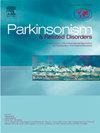Drooling in Parkinson's disease: A potential clinical marker of disease severity
IF 3.4
3区 医学
Q2 CLINICAL NEUROLOGY
引用次数: 0
Abstract
Introduction
Drooling is a common but underrecognized non-motor symptom in Parkinson's disease (PD), associated with impaired quality of life and aspiration risk. While often managed as a peripheral issue, it may reflect broader systemic involvement. This study aimed to evaluate the prevalence and clinical significance of drooling in PD, focusing on its relationship with motor, non-motor, cognitive, and autonomic domains.
Methods
We conducted a cross-sectional study involving 513 Japanese PD patients. Drooling severity was assessed using Item 2 of the MDS-UPDRS Part II. Motor and non-motor symptoms were evaluated using the MDS-UPDRS Parts I–IV, MMSE, MoCA-J, FAB, PDSS-2, JESS, and PDQ-39. Cardiac sympathetic innervation and dopaminergic integrity were assessed using MIBG myocardial scintigraphy and DaT SPECT, respectively. Multivariable regression analysis was performed with adjustment for age, sex, and disease duration.
Results
Drooling was observed in 66.5 % of participants, with 28.1 % categorized as severe. Droolers had significantly worse scores in motor and non-motor assessments, poorer sleep quality and quality of life, and greater cognitive deficits. They also exhibited lower heart-to-mediastinum ratios on MIBG and reduced striatal z-scores on DaT SPECT. These associations remained significant after adjustment for covariates.
Conclusion
Drooling in PD is linked to broader clinical and imaging abnormalities and may reflect widespread neurodegeneration beyond oropharyngeal dysfunction. These findings support the potential utility of drooling as a clinical marker of disease severity and suggest that it warrants greater attention in both research and clinical practice.
帕金森病的流口水:疾病严重程度的潜在临床标志
流口水是帕金森病(PD)中一种常见但未被充分认识的非运动症状,与生活质量受损和误吸风险相关。虽然它通常被当作一个外围问题来处理,但它可能反映出更广泛的系统性参与。本研究旨在评估PD患者流口水的患病率及其临床意义,重点探讨其与运动、非运动、认知和自主神经领域的关系。方法对513例日本PD患者进行横断面研究。使用MDS-UPDRS第二部分第2项评估流口水严重程度。运动和非运动症状采用MDS-UPDRS part I-IV、MMSE、MoCA-J、FAB、PDSS-2、JESS和PDQ-39进行评估。心脏交感神经支配和多巴胺能完整性分别用MIBG心肌显像和DaT SPECT评估。进行多变量回归分析,调整年龄、性别和疾病持续时间。结果66.5%的参与者出现流口水,其中28.1%为重度流口水。流口水的人在运动和非运动评估中得分明显较低,睡眠质量和生活质量较差,认知缺陷更大。他们在MIBG上也表现出较低的心脏与纵隔比率,在数据SPECT上也表现出较低的纹状体z分数。在调整协变量后,这些关联仍然显著。结论PD患者流口水与更广泛的临床和影像学异常有关,可能反映了口咽功能障碍以外广泛的神经退行性变。这些发现支持流口水作为疾病严重程度的临床标志的潜在效用,并建议在研究和临床实践中给予更多关注。
本文章由计算机程序翻译,如有差异,请以英文原文为准。
求助全文
约1分钟内获得全文
求助全文
来源期刊

Parkinsonism & related disorders
医学-临床神经学
CiteScore
6.20
自引率
4.90%
发文量
292
审稿时长
39 days
期刊介绍:
Parkinsonism & Related Disorders publishes the results of basic and clinical research contributing to the understanding, diagnosis and treatment of all neurodegenerative syndromes in which Parkinsonism, Essential Tremor or related movement disorders may be a feature. Regular features will include: Review Articles, Point of View articles, Full-length Articles, Short Communications, Case Reports and Letter to the Editor.
 求助内容:
求助内容: 应助结果提醒方式:
应助结果提醒方式:


